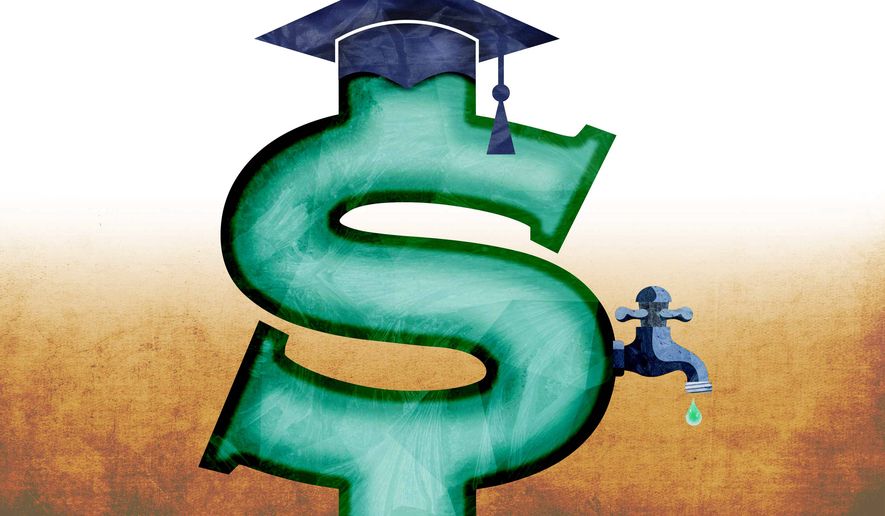OPINION:
Congress will be reauthorizing the Higher Education Act of 1965 and in the process will consider how to finance and reduce the cost of graduate and professional student education more efficiently — we hope. The Grad PLUS loan program is set to spend some $100 billion taxpayer dollars over the next 10 years unrelated to the needs of the current U.S. labor force needs. Setting the money aside, there are other more substantive reasons for eliminating this program.
Market costs rise when the government artificially boosts demand. Education, lauded as a fix for all of society’s ills, is not immune from the market. The unemployment rates for 50+ professionals and for graduate and professional education holders shattered the idea that education was a universal fix for career uncertainty, especially as young IT professionals outpaced their salaries for almost a generation. Coupling Grad PLUS loans with loan forgiveness and multiple repayment plans encourages overborrowing and frees schools from the responsibility to charge prices that actually match the market value of the degrees they offer. This is a major reason why tuition has skyrocketed in recent years, feeding funding into the study not of realistic educational needs for work readiness, but also increasingly to new fields of study unrelated to jobs-at-hand.
Federal student loans make some sense helping undergraduates who might not otherwise be able to afford college get an education, although the money has been directed not to the academically qualified but to the financially disadvantaged, regardless of their ability to apply what is taught. However, the problems are compounded by university financial incentives when the federal government virtually guarantees access to graduate and professional institutions at any price and even regardless of the quality of the degree or certificate program. Simple economics tells us that student debt will increase, college costs will increase, and student success rates will decrease.
Higher education is not a pure public good, and graduate and professional education should be revered as a private good.
Vigorously promoting the axiom that people value what they pay for and will pay for what they value will broaden educational opportunity, raise the quality of graduate and professional education, and simultaneously lower governmental expenditures. From a burden-sharing perspective, graduate and professional education degrees are almost always worth their cost. Since the lifetime earnings of these students will average 2-4 times that of high school graduates with no postsecondary education, students should not be looking to their neighbors (70 percent of whom do not have a college degree) to shoulder their self-created student loan “burdens.”
The irony of the current federal direct loan program structure is that graduate and professional students are being charged significantly more relative to their risk, and taxpayers now having much greater exposure due to the projected cost of loan forgiveness, repayment plan options, and other policies originally intended to serve needy undergrads. The Federal Government has been making a 13-35 percent net gain from grad PLUS loans in recent years; the current interest rate is 6.31 percent and an extra 4.276 percent fee is deducted from the loan amount (nearly 400 percent of what undergraduates are charged). Moreover, while graduate and professional student federal loan balances are much higher than for undergraduates, their default rate is only 7.6 percent (even less in the private loan market), compared to 21 percent among undergraduate borrowers. Yet the Federal Government is charging them 36-59 percent higher interest — the opposite of how private sector lenders price loans based on risk.
As currently designed, Grad PLUS seeks to balance the budget of the federal student aid system on the backs of graduate and professional students.
Eliminating Grad PLUS would restore only 6 percent of the current federal student loan market to the private sector, yet enable Congress to provide access to more equitable financing options, bring down college costs, increase the incentive for graduate and professional schools to price their programs according to their market value, and enable these students to better assess the market value of their chosen programs before attending school. In time, Congress may also conclude that eliminating the unsubsidized Stafford Loan Program for graduate students would be prudent. This would save taxpayers another $350 billion over 10 years and reduce federal involvement in student lending another 18 percent, thereby reducing the total federal share of all student loan financing from 92 percent to roughly 68 percent; but first things first.
The “imperfections” that validate a rational need for continuing federal intervention in the graduate and professional student loan market do not exist. There are no market imperfections, just distortions.
• Ronald Bearse is a partner at Senior Business Consultants, LLC in Hyannis, Mass. and a former education financing company executive.




Please read our comment policy before commenting.